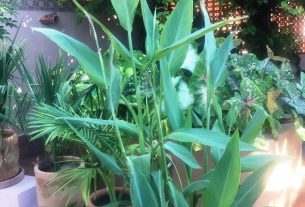By Tommy Clarkson from the January 2015 Edition
Nephrolepis exaltata
Family: Lomariopsidaceae or Davalliaceae
(Also known as: Sword Fern, Wild Boston Fern, Tuber Ladder Fern, or Fishbone Fern)

Who hasn’t heard of a Boston Fern? As I recall, my first contact with such was some sixty years ago when my grandmother, Rose Unruh, had a large, healthy specimen. All ferns I have since met have been consciously compared to hers!
As to the origin of this species, that’s open for debate. It’s a pretty good bet that they didn’t begin out in the countryside around Boston! The base plant probably came from tropical America. But the form we know apparently originated in the late 1800’s when plants of a particular form of N. exaltata became popular in nurseries around that area.
One story supporting such speculation is that the “Boston fern originated in a shipment of 200 plants sent from a Philadelphia florist to F. C. Becker, a florist in Cambridge, Mass. Mr. Becker recognized (that) one plant in the shipment was faster growing, had wider fronds and an unusual drooping habit, instead of the stiffly upright form of the species. He began to propagate it in 1894. Two years later, botanists in London identified the plant and suggested the Boston name for the variant form.”
According to Philip Perl, author of “Ferns”, “This original mutant (has) more graceful fronds than Sword Ferns and (has been) the founder of a whole line of attractive freaks (so much that) by 1920 about 75 varieties were known.”
The leaflets of the Boston fern are alternately arranged contrary to most other species of ferns and are united in a somewhat parallel plane along its rachis (the main shaft of the frond).
As a genus, ferns number around thirty different species and are found all over the tropical and subtropical world. Most of the species are referred to as Sword Ferns what with the typical shape of the frond being long and narrow.
Let’s briefly speak of longevity. Suffice it to say that ferns, overall like cycads have been around a long, long time. “The Age of Ferns” evolved well before there were flowering plants. An example of such is a fossil of a Pepcopteris miltoni that was found in an Illinois coal mine. It had lived 280 million years ago in a Paleozic-era swamp. However, it looks virtually identical to its modern form. Humans have been around, reasonably as we are today, for a mere 100,000 years which begs the question as to what life forms have true staying power!

Whatever and whenever its beginnings, it is today perhaps the most popular of all ferns grown indoors. Low in maintenance requirements, loving partial shade and requiring but a medium amount of water, they will grow as wide as they grow tall (something I sometimes fear my body may be striving to attain) at two to three feet in all directions.
The University of Florida Extension Service describes the Nephrolepis exaltata as “a dependable, easy-to-grow fern (that) produces great masses of long, narrow, pale green leaves, creating beautiful hanging baskets or gently arching out of raised containers. But (they) also make a wonderful ground cover, creating a dense, tropical effect, (with its) graceful fronds quickly spreading over the ground by means of thin, green runners.” Well said!
Its fronds are 20 to 99 inches (50–250 cm) long and 2 ½ to 6 inches

(6–15 cm) broad, with alternate pinnae (these are the small “leaflets” on either side of the midrib). Each one of these is 0.8 to 3.2 inches (2–8 cm) long.
Today, there are some fun variants readily available at many nurseries. Boston Fern cultivars such as ‘Fluffy Ruffles’, ‘Rooseveltii’, and ‘Whitmanii’ all have more finely cut and feathery fronds than the classic original.
Propagation can be easily done by simple division of the clumps. I prefer to gently tear them apart with my hands as opposed to cutting them with a knife.
As for normal plant problems, the Boston Fern may at times be bothered by scale, mites, mealy bugs, snails, or slugs and, occasionally, fungal diseases may be a problem. But, as a rule, such should not be a major concern if proper care is taken.
Should one feed it? Yes. Nephrolepis exaltata needs a fertilizer with a balance of nitrogen, phosphorous and potassium, such as 10-10-10, 13-13-13, 16-16-16 or 2020-20. How often, however, is open to debate among growers. I’d say try once a month during growing season and see how it does.
For back issues of “Roots”, gardening tips, tropical plant book reviews and videos of numerous, highly unique eco/ adventure/ nature tours, as well as memorable “Ultimate Experiences” such a Tropical Garden Brunches. Visit us at www.olabrisagardens.com
Download the full edition or view it online
—
Tommy Clarkson is a bit of a renaissance man. He’s lived and worked in locales as disparate as the 1.2 square mile island of Kwajalein to war-torn Iraq, from aboard he and Patty’s boat berthed out of Sea Bright, NJ to Thailand, Germany, Hawaii and Viet Nam; He’s taught classes and courses on creative writing and mass communications from the elementary grades to graduate level; He’s spoken to a wide array of meetings, conferences and assemblages on topics as varied as Buddhism, strategic marketing and tropical plants; In the latter category he and Patty’s recently book, “The Civilized Jungle” – written for the lay gardener – has been heralded as “the best tropical plant book in the last ten years”; And, according to Trip Advisor, their spectacular tropical creation – Ola Brisa Gardens – is the “Number One Tour destination in Manzanillo”.





You must be logged in to post a comment.